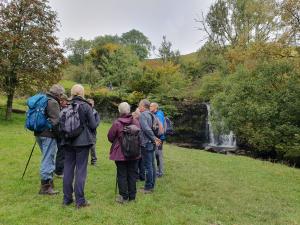At the end of September, SWAAG members enjoyed a walk to look at the geology and industrial archaeology of the Swale valley, near Keld. It was led by Les Knight, who began by explaining how the underlying Yoredale rocks were laid down during the Carboniferous period when, as result of plate tectonics, the British Isles lay much nearer the equator. Limestones formed in the warm tropical seas and were later buried by sediments washed in by rivers draining the surrounding land surfaces. Over time these compacted to become mudstones, shales and sandstones and the sequence was then repeated over ten times as sea levels rose and fell. Only the later of these ‘cyclothems’ are visible at Keld.
Since being uplifted the rocks have been weathered and eroded. Today the limestones form the steeper cliffs and waterfalls, whilst the less resistant mudstones and shales form the gentler slopes. Faulting has also affected the landscape by bringing different rock types into close juxtaposition. We stopped to look at the limestones at Kisdon Force and an outcrop of shales higher up the track. Further along we looked for crinoid fossils. Sue explained how lichens can be used to distinguish between limestones and sandstones.
Relics of the lead mining industry can be seen across the slopes of Beldi Hill. There are hushes, spoil heaps and derelict buildings. Les explained how shafts and adits were used to access the mineral veins deep below ground. It was during one of these explanations that he was totally upstaged by a large owl which was having a nap, right in front of us, in a hollow tree. Startled, it flew away directly over our heads.
We finished our walk at the ruins of Crackpot Hall where we had lunch. The weather was much kinder than on our previous visit!
J.H. |



